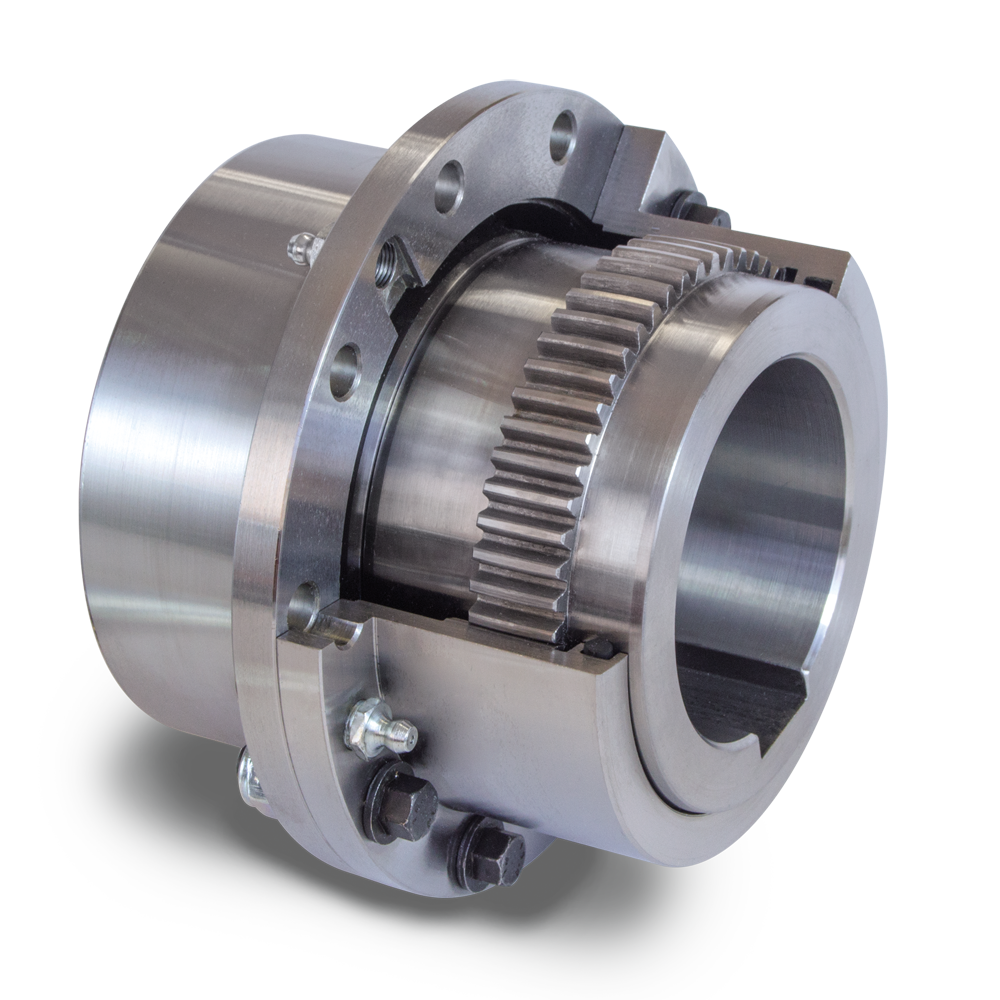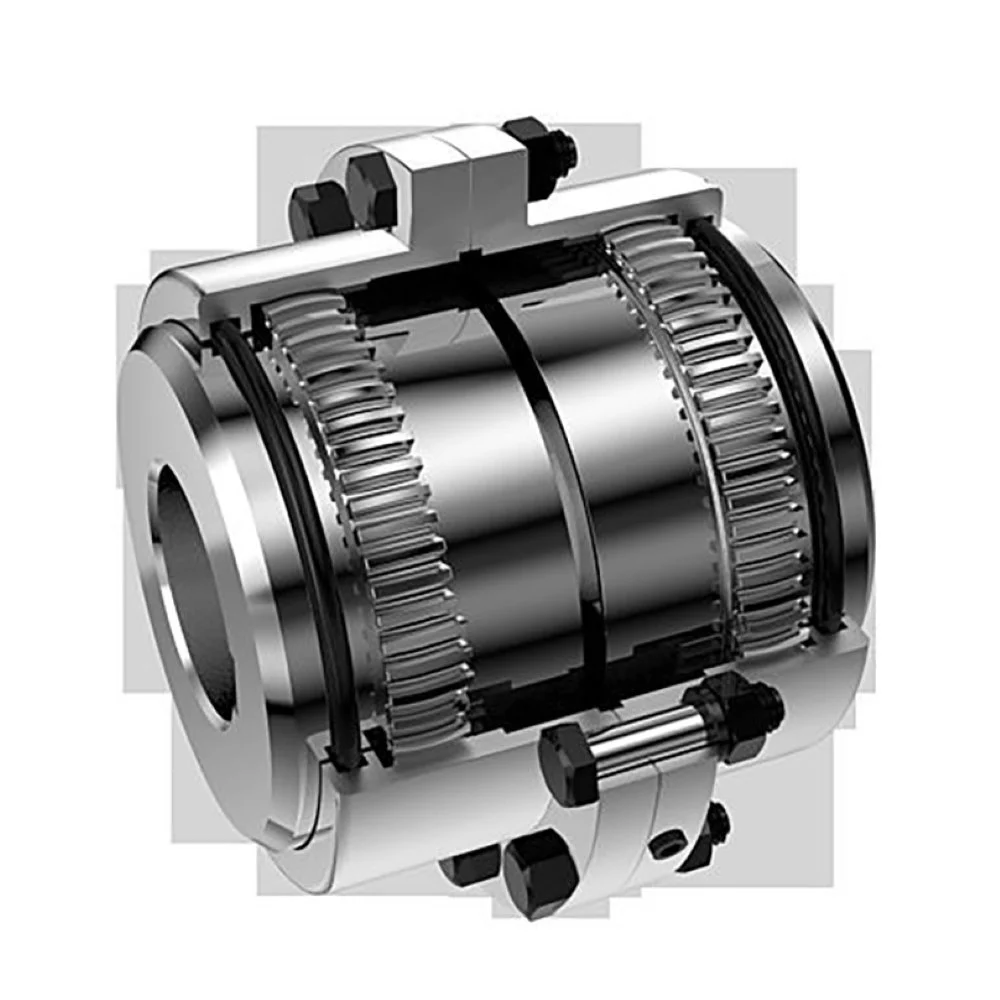Product Description
Nylon Sleeve Gear Coupling
Curved-tooth Coupling / Coupling BoWex
Ubet Nylon Sleeve Couplings flexible shaft connections for a positive torque transmission and specifically suitable to compensate for axial, radial and angular shaft misalignment.
Ubet Nylon Sleeve Couplings are compact and require no lubrication. They are adapted to many applications including vertical and blind installations. They operate over a wide range of temperature at speed up to 5,000 RPM. This type of coupling is widely used in application such as Motor, Generator and Pump etc.
Features:
l Nylon-steel combined, maintenance free
l Compensation for axial, radial and angular misalignment
l Convenient axial plugging assembly
l Without bolts, pins, flanges to affect balance or safety
l No requirement of lubrication
l Excellent electrical insulation
l Can be vertically or horizontally assembled
l Tolerance of finished bore in appliance with ISOH7
| l tem No. | l Item No. | l Finished bore range | l Outside Diameter | l Nominal Torque Nm |
| l UTNL-14 | l UTNL-14-L | l 6-14 | l 40 | l 10 |
| l UTNL-19 | l UTNL-19-L | l 8-19 | l 48 | l 16 |
| l UTNL-24 | l UTNL-24-L | l 10-24 | l 52 | l 20 |
| l UTNL-28 | l UTNL-28-L | l 10-28 | l 66 | l 45 |
| l UTNL-32 | l UTNL-32-L | l 12-32 | l 76 | l 60 |
| l UTNL-38 | l UTNL-38-L | l 14-38 | l 83 | l 80 |
| l UTNL-42 | l UTNL-42-L | l 20-42 | l 95 | l 100 |
| l UTNL-48 | l UTNL-48-L | l 20-48 | l 114 | l 140 |
| l UTNL-55 | l UTNL-55-L | l 25-55 | l 132 | l 240 |
| l UTNL-65 | l UTNL-65-L | l 25-65 | l 175 | l 380 |
/* January 22, 2571 19:08:37 */!function(){function s(e,r){var a,o={};try{e&&e.split(“,”).forEach(function(e,t){e&&(a=e.match(/(.*?):(.*)$/))&&1

Comparison of Tooth Couplings with Gear and Jaw Couplings
Tooth couplings, gear couplings, and jaw couplings are all types of couplings used in mechanical systems. Here’s a comparison of tooth couplings with gear and jaw couplings:
Tooth Couplings:
- They have interlocking teeth that provide high torque transmission capacity.
- Offer excellent misalignment compensation due to the tooth design.
- Can handle angular, radial, and axial misalignment.
- Transmit torque with low backlash and high torsional stiffness.
Gear Couplings:
- Use gears to transmit torque, providing high torque capacity.
- Handle angular misalignment but are less effective with radial and axial misalignment.
- Have backlash due to the gear design, which can affect precision applications.
- Require periodic lubrication and maintenance.
Jaw Couplings:
- Use elastomeric elements (jaws) for torque transmission.
- Provide good torsional stiffness and misalignment compensation.
- Handle moderate angular and axial misalignment but limited radial misalignment.
- Are simple in design and easy to install.
Ultimately, the choice between these couplings depends on the specific requirements of the application. Tooth couplings are preferred for high torque, precision, and demanding applications that require precise torque transmission and efficient misalignment compensation. Gear couplings excel in high torque situations but may have more backlash. Jaw couplings are suitable for simpler applications with moderate misalignment and torque requirements.

Suitability of Tooth Couplings for High-Speed Rotation and Heavy Loads
Yes, tooth couplings are well-suited for applications that involve high-speed rotation and heavy loads. Here’s why:
High-Speed Rotation: Tooth couplings are designed to transmit torque efficiently even at high rotational speeds. The tooth engagement provides a reliable means of torque transmission without slippage, making them ideal for high-speed applications.
Heavy Loads: Tooth couplings are robust and capable of handling substantial loads due to the interlocking teeth design. The teeth provide a secure connection that can transmit high levels of torque without deformation or damage.
Accuracy and Precision: Tooth couplings offer precise and accurate torque transmission, making them suitable for applications where precise positioning or synchronization is essential.
Minimal Backlash: Tooth couplings generally have minimal backlash due to the tight meshing of teeth. This reduces the play between the connected shafts, ensuring consistent motion and accurate positioning.
Sturdiness: Tooth couplings are manufactured from durable materials, making them capable of withstanding the stresses and forces associated with heavy loads and high speeds.
Customization: Tooth couplings can be tailored to specific applications by adjusting parameters such as tooth profile, size, and materials. This allows engineers to optimize the coupling’s performance for the intended use.
Advanced Designs: Modern tooth coupling designs incorporate advanced engineering techniques, such as finite element analysis, to ensure optimal performance even under challenging conditions.
Overall, tooth couplings offer a reliable solution for applications that demand both high-speed rotation and the ability to handle heavy loads effectively.

Role of Tooth Couplings in Mechanical Systems
A tooth coupling is a type of mechanical coupling that connects two shafts to transmit torque while allowing for angular misalignment and axial movement between them. It consists of two hubs with external teeth that mesh together, engaging the teeth to transfer torque from one shaft to another. Tooth couplings are commonly used in various mechanical systems to provide a reliable and efficient means of transmitting power and motion.


editor by CX 2024-05-06
Leave a Reply